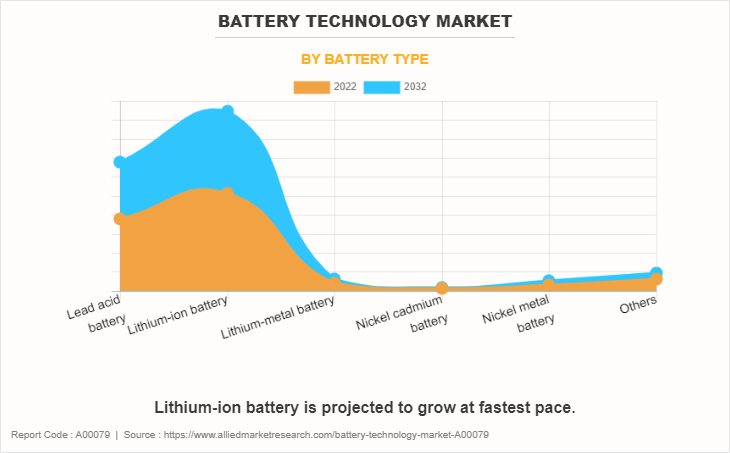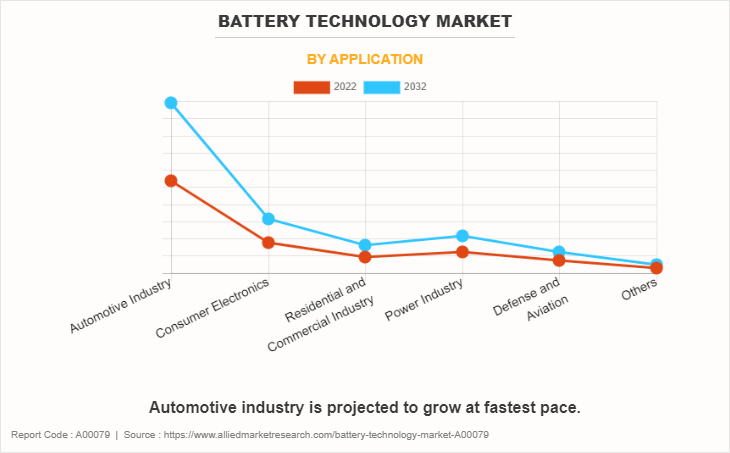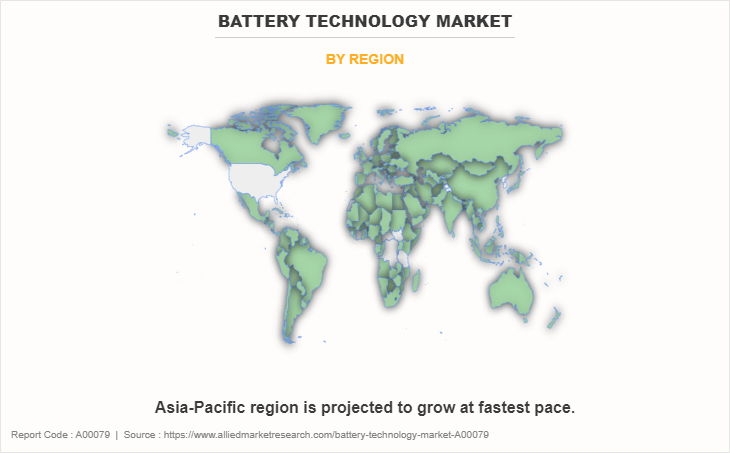Battery Technology Market Research, 2032
The global battery technology market was valued at $102.9 billion in 2022, and is projected to reach $185 billion by 2032, growing at a CAGR of 5.9% from 2023 to 2032.
Key Report Highlighters:
- The report outlines the current battery technology market trends and future scenario of the market from 2023 to 2032 to understand the prevailing opportunities and potential investment pockets.
- The global battery technology market has been analyzed in terms of value ($ billion). The analysis in the report is provided for 4 major regions and more than 15 countries.
- The battery technology market is fragmented in nature with few players such as Exide Industries Ltd., Hitachi Ltd., Samsung SDI Co., Ltd., Sony Corporation, and General Electric. which hold a significant share of the market.
- The report provides strategy planning and industry dynamics to enhance decision making for existing market players and new entrants entering the market.

Battery is a device with a purpose to store and release electrical energy as and when required. The development and design of the battery device is technically termed as battery technology. Batteries have several applications such as in electric vehicles, consumer electronics, and renewable energy storage.
The electric vehicle market is experiencing exponential growth with sales reaching about 10 million in 2022. The electric vehicles had a 14% share in the overall automobile sales across globe. China, Europe, and the U.S. were three major contributors in the sales of electric vehicles with a collective share of 60%. China led the market for electric vehicles in 2022 and has achieved its 2025 goal of shift to electric vehicles already. Europe experienced a 15% increase in the sales of electric vehicles. Such trends in the electric vehicle market majorly contribute towards the rising demand for batteries. Thus, there is relative growth in the demand for battery technologies, especially lithium-ion batteries.
The growing need for portable electronics has also contributed to the expansion of the battery technology market. With rise in demand for lithium-ion batteries, increase in the production of lithium in 2021 was registered of about 180%. For clean battery technologies, lithium is a critical mineral that plays an important role in the support of energy transitions. Increased focus on innovation is expected to propel advancements in existing battery technologies.
Battery technology has advanced very slowly, owing to the complicated chemistry involved and the difficulties in commercializing while ensuring safety. However, advancements in battery technology are expected to result in better energy availability and performance from consumer gadgets. New developments in battery technology will be capable of offering longer-lasting smartphones, dependable electric vehicles, more effective energy storage for large-scale structures, and even grid-level energy storage. Concerns about the safety and environmental impact of battery disposal and the source of raw materials might potentially be addressed by new designs. Even the most promising battery trials, require extensive research and development before they are included in the gadgets.
The battery technology market is dynamic and is experiencing continuous innovation and developments. The lithium-ion batteries are currently dominating the market growth for battery technologies, however, there are several ongoing researches which are focused on alternative technologies such as solid-state batteries and next-generation chemistries that include organic electrolytes as potential. The growing market of electric vehicles is also fostering the growth of battery technologies market. Moreover, the integration of renewable energy sources also acts as a key driving factor for shaping the future of battery technology industry.
Market Dynamics
Renewable energy integration to boost battery technology market growth
Battery technology helps in overcoming various challenges that come with excess energy produced from renewable sources such as solar and wind. Batteries help in storing the excess amount of energy generated and are also capable of releasing them when required. Since solar and wind power generation very much relies on the weather conditions, storing access energy during peak seasons allows reliable and consistent power supply. Batteries enable the process of storing the surplus energy and releasing it upon requirement. Integration of batteries with renewable energy sources also ensures grid stability as it also provides a buffer against sudden fluctuations during supply demand.
Batteries can respond rapidly to changes in energy requirements, helping to balance the grid and prevent blackouts. Batteries can be used for peak shaving, where stored energy is discharged during periods of high demand, reducing the need for additional power plants to be brought online temporarily. Load balancing involves using batteries to smooth out fluctuations in energy demand and supply, optimizing grid performance. Battery technology enables the stability of renewable energy, making it a more reliable and predictable source. Energy stored during times of high generation compensates for periods when renewable output is low or unavailable. Ongoing research focuses on advancing battery technologies, including improving energy density, cycle life, and safety, to make energy storage more efficient and cost-effective.
Batteries are capable of responding rapidly during the changes in energy demand. This helps in balancing the grid and also prevents blackouts. During high demands, these batteries are used for peak shaving so the stored energy can be discharged which further helps in reducing the need for temporary power plants. For load balancing, batteries are used to manage fluctuations which helps in enhancing grid performance. It also offers stability which makes renewable sources of power generation more efficient and predictable. The ongoing research into the battery technologies is focused on improving energy density, charge cycle life, and safety which also enhances efficiency of battery storing.
The integration of renewable energy and battery technology plays an important role in attaining sustainable and resilient energy systems. Globally, several governments, utility companies, and private businesses are investing heavily into energy storage solutions to enhance the efficiency and reliability of renewable energy sources which will further aid in smoother energy transition. Such factors drive the growth of the battery technology market.
Raw material procurement and cost challenges
Lithium, cobalt, nickel, and rare earth elements are major raw materials that are used in battery production. These metals are distributed unevenly across the earth’s geography. Some countries such as Chile, China, and Australia hold large reserves of lithium as well have efficient production chain. However, geopolitical factors, supply chain dynamics, and market demand impact the cost of these raw materials. Therefore, a stable and cost-effective supply chain is very crucial for managing the cost of battery production. Development of efficient manufacturing processes and innovation of new technologies to reduce labor costs and improve yield is an important factor for the market growth. To lower down the per unit cost of battery production, achieving economies of scale is very important.
The battery sector is highly dependent on a select few essential raw resources, including cobalt and lithium. The price and availability of these resources can be impacted by supply chain interruptions, trade policy changes, and geopolitical concerns. The exploitation of some raw materials—cobalt, in particular—has sparked ethical and environmental questions. The sector has issues in ensuring ethical sourcing procedures and mitigating the environmental effects of mining. It is difficult to lessen reliance on certain areas for the supply of raw materials. There is continuous work being done to create substitute materials with comparable performance attributes and to diversify the sources. Raw material costs might fluctuate, which affects the manufacture of batteries overall in terms of cost. To navigate these swings, strategic planning and risk management are essential.
The life cycle of a battery includes several stages, including extraction of raw materials, manufacture, usage, and recycling or disposal at the end of the battery's useful life. When minerals like lithium, cobalt, nickel, and rare earth elements are mined for batteries, the ecosystem may suffer from disturbed habitats, degraded soil, and contaminated water. The extraction of some materials—cobalt in particular—has sparked ethical questions about human rights abuses and working conditions in some mining operations. Energy-intensive battery manufacturing methods can increase greenhouse gas emissions if they employ energy from non-renewable sources. If not appropriately controlled, the use of chemicals in manufacturing processes—such as coatings and solvents—may have an adverse effect on the environment.
During the usage phase, greenhouse gas emissions from electric automobiles and other battery-powered applications are often lower than those from traditional internal combustion engine vehicles. The total effect is contingent upon the energy blend employed in the production of electricity. Because batteries may contain dangerous elements, improper battery disposal can contaminate the environment. To recover valuable materials and reduce environmental impact, it is imperative to develop recycling processes that are both efficient and cost-effective. The intricacy of battery chemistries and the requirement for specialized recycling infrastructure present challenges. There are worries over resource depletion and the environmental effects of continuing to extract particular raw materials used in batteries, such cobalt and lithium, due to their increasing demand.
Grid-scale energy storage
Battery technology has a large and expanding opportunity in grid-scale energy storage. Grid-scale energy storage technologies are essential for mitigating the intermittent nature of renewable energy sources, such wind and solar power, as demand for them rises. Renewable energy sources are erratic and sporadic, like wind and solar power. With the use of battery technology, extra energy produced during times of peak production may be stored and released during times of high demand or low production of renewable energy. system-scale energy storage balances supply and demand, improving system stability. In order to maintain a dependable and stable electrical grid, batteries can react quickly to changes by regulating frequency and supporting the grid.
Peak shaving, in which stored energy is released at times of high electricity demand, may be accomplished using grid-scale batteries, negating the need to temporarily bring extra power units online. This aids in distributing the grid's burden. Batteries allow the production of renewable energy to be time-shifted. It is possible to store extra energy produced during times of high renewable energy output for use during times of low renewable energy production. The seamless grid integration of renewable energy sources is made possible by battery technology. Batteries make it possible for an electrical supply to be more dependable and steadier by acting as a buffer for energy storage. Batteries installed on a grid-scale prevent surplus renewable energy from being cut off when demand is low. The energy that is produced can be stored for later use rather than being wasted. In order to accommodate growing demand, grid-scale energy storage can lessen the need to develop additional power plants or extend the electrical system. Meeting periods of peak demand may be more affordable using this approach.
Segments Overview
The battery technology market size is segmented on the basis of battery type, application, and region.

By battery type, the market is classified into lead acid battery, lithium-ion battery, lithium-metal battery, nickel cadmium battery, nickel metal battery, and others. The lithium-ion segment accounted for 49.7% battery technology market share in 2022 and is expected to maintain its dominance during the battery technology market forecast period. Although lithium-ion batteries have dominated the market, research into other technologies is still underway. The development of ecologically friendly and sustainable battery technology is becoming more and more important. To reduce its negative effects on the environment, the industry is looking at recycling and repurposing batteries.

By application, the market is segmented into automotive industry, consumer electronics, residential and commercial industry, power industry, defense and aviation, and others. The automotive segment accounted for 52.1% battery technology market share in 2022 and is expected to maintain its dominance during the forecast period. The automotive industry has seen a notable shift towards electric vehicles as a means to reduce carbon emissions and dependency on fossil fuels. Battery technology is a critical component in the development and adoption of electric vehicles, powering their electric drivetrains.

Region-wise, the battery technology market is analyzed across North America, Europe, Asia-Pacific, and LAMEA. Asia-Pacific accounted for 44.0% battery technology market share in 2022 and is expected to maintain its dominance during the forecast period. The Asia-Pacific market for battery technology has been dynamic, driven by factors such as the rapid adoption of electric vehicles (EVs), the growth of renewable energy, and increasing demand for energy storage solutions. China is a global leader in electric vehicle adoption, driving significant demand for batteries, particularly lithium-ion batteries.
Key players operating in the battery technology industry include Exide Industries Ltd., Hitachi Ltd., Samsung SDI Co., Ltd., Sony Corporation, General Electric, Honda Motor Co., Ltd., Honeywell International Inc., BAK Power Battery Co., Ltd., Fujitsu, and American Battery Charging Inc.
Recent Developments In The Market:
- In November 2023, GE Vernova and Our Next Energy Inc. (ONE) signed a term sheet to collaborate towards advancing battery energy storage solutions in the U.S., using locally manufactured batteries. This collaboration covers the supply of the U.S.-made lithium iron phosphate battery modules and cells by ONE for GE Vernova's solar & storage solutions business projects in the U.S.
- In October 2021, Honeywell International Inc. announced a new flow battery technology that works with renewable generation sources such as wind and solar to meet the demand for sustainable energy storage. This new flow battery uses a safe, non-flammable electrolyte that converts chemical energy to electricity to store energy for later use while meeting the environmental, longevity and safety objectives of utilities.
Key Benefits for Stakeholders
- This report provides a quantitative analysis of the market segments, current trends, estimations, and dynamics of the battery technology market analysis from 2022 to 2032 to identify the prevailing battery technology market opportunities.
- The market research is offered along with information related to key drivers, restraints, and opportunities.
- Porter's five forces analysis highlights the potency of buyers and suppliers to enable stakeholders make profit-oriented business decisions and strengthen their supplier-buyer network.
- In-depth analysis of the battery technology market segmentation assists to determine the prevailing market opportunities.
- Major countries in each region are mapped according to their revenue contribution to the global market.
- Market player positioning facilitates benchmarking and provides a clear understanding of the present position of the market players.
- The report includes the analysis of the regional as well as global battery technology market trends, key players, market segments, application areas, and market growth strategies.
Battery Technology Market Report Highlights
| Aspects | Details |
| Market Size By 2032 | USD 185 billion |
| Growth Rate | CAGR of 5.9% |
| Forecast period | 2022 - 2032 |
| Report Pages | 280 |
| By Application |
|
| By Battery Type |
|
| By Region |
|
| Key Market Players | Sony Corporation, Hitachi Ltd., Honeywell International Inc., General Electric, Samsung SDI Co., Ltd., Fujitsu, American Battery Charging Inc., BAK Power Battery Co., Ltd., Honda Motor Co., Ltd., EXIDE INDUSTRIES LTD. |
Analyst Review
According to the insights from the CXOs, the battery technology market is experiencing exponential growth. The existing battery technologies are driving the overall industry growth, owing to continuous advancements. The major driving factor for the battery technology industry is the transition to clean energy. Climate change concerns, rural & urban infrastructure electrification, electrification of vehicles, and renewable energy integration have propelled the battery technology market growth. However, price fluctuations of raw materials and concerns regarding disposal of these batteries constantly remain a challenge for industry growth. Meanwhile, grid-scale energy storage is a significant and growing opportunity for battery technology market, owing to rise in demand for renewable energy sources such as wind and solar.
Renewable energy integration and rise in demand for electric vehicles are the upcoming trends of Battery Technology Market in the world.
Automotive industry is the leading application of Battery Technology Market.
Exide Industries Ltd., Hitachi Ltd., Samsung SDI Co., Ltd., Sony Corporation, General Electric, Honda Motor Co., Ltd., Honeywell International Inc., BAK Power Battery Co., Ltd., Fujitsu, and American Battery Charging Inc. are the top companies to hold the market share in Battery Technology.
The Asia-Pacific is the largest regional market for Battery Technology.
$185.0 billion is is the estimated industry size of Battery Technology industry by 2032.
Loading Table Of Content...
Loading Research Methodology...



